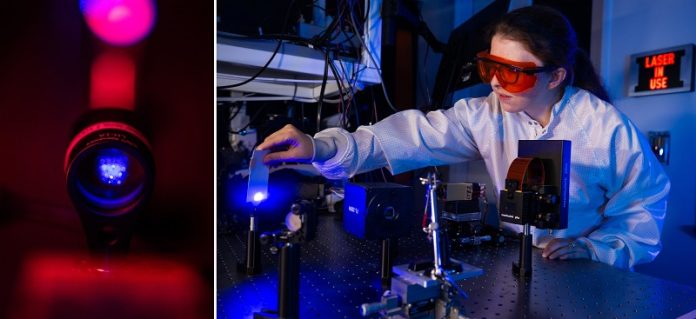
Researchers at Rice University have developed a groundbreaking soft robotic arm that moves using only laser light—no wires, motors, or batteries required.
This new approach combines light-sensitive materials, artificial intelligence, and precise laser control to create a robot that can perform complex tasks like weaving around obstacles or hitting a ball.
The soft robot is made from a special type of material called a liquid crystal elastomer. When this material is hit with blue laser light, it shrinks, and when the light turns off, it quickly returns to its original shape.
This quick response allows for real-time control of the robot’s movements. Unlike other materials that require harsh ultraviolet light or take minutes to reset, this new material works safely and resets in just seconds.
In a study published in Advanced Intelligent Systems, the Rice team showed that they could guide the robot’s motion by splitting one laser beam into many smaller beams and shining them on different parts of the robotic arm.
Each of these tiny laser beams can be turned on or off and adjusted in brightness.
When the light hits the material, it bends toward the light, much like how a plant bends toward the sun. By carefully controlling where the laser hits, the researchers made the robot arm move in smooth, complex ways—similar to how an octopus moves its tentacles.
The real innovation lies in how the robot decides what to do. The team used artificial intelligence to train a computer model to predict exactly which light patterns would make the robot move in a certain way.
By feeding the AI with examples of how the arm reacted to different laser settings, it learned to generate the correct laser commands for any desired shape or movement.
This research marks the first time a soft robotic arm made from light-sensitive material has been guided in real time using AI and laser control. The robot can move in two dimensions for now, but future versions could move in 3D with added sensors and cameras.
This new kind of robot could one day be used in delicate situations where traditional robots are too bulky or rough—such as in medical devices placed inside the human body or in factories handling fragile materials.
Because it doesn’t require any built-in electronics, the robot could also be safer and easier to design for special environments.
The project brings together experts in materials science, engineering, optics, and machine learning. It’s an exciting step forward in soft robotics, proving that light and AI together can create highly flexible, intelligent machines.



